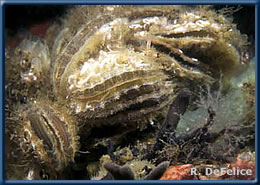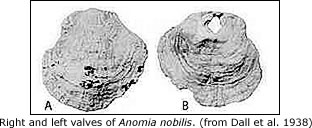

Anomia nobilis

Crassostrea virginica

Chama macerophylla

Crucibulum spinosum
Anomia nobilis
 Jingle
shell, Saddle oyster
Jingle
shell, Saddle oyster
Phylum Mollusca
Class Bivalvia
Family Anomiidae
Description
Jingle shells superficially resemble true oysters, but their mode of attachment,
a byssal plug passing through an opening in the right (lower) valve, and
their delicate translucent shells distinguish them. Shells are orbicular,
irregular and distorted, and thin. The upper shell (left valve) is somewhat
convex and milk-white, beige or pale green. The shells have scalelike,
concentric lamellae sculpturing with slanting radiating threads. Many
individuals are commonly found piled one on top of the other in the fouling
community (from Kay, 1979).
Habitat
 A
very common fouling organism, typically found on pier pilings and floating
docks in harbors in characteristic stacks (one on top of the other). Also
found inter-tidally on the under surface of flat stones.
A
very common fouling organism, typically found on pier pilings and floating
docks in harbors in characteristic stacks (one on top of the other). Also
found inter-tidally on the under surface of flat stones.
Distribution
Hawaiian Islands
In harbors throughout the main islands
Native Range
Indo-Pacific
Present Distribution
Widespread Indo-Pacific and Hawaiian Islands
Mechanism of Introduction
Unintentional, most likely as fouling on ships' hulls
Impact
Fouling organism. Ecological impact unstudied, but observations suggest
competition for space with other fouling invertebrates
Ecology
Feeding
Bivalves are suspension feeders. Water is moved through an incurrent siphon
into the mantle cavity by cilia on the ctenidia (gills). Water passes
over the ctenidia, food particles are extracted by the cilia, and water
is expelled through an exhalent siphon.
Reproduction
Bivalves are typically gonochoristic (having separate male and female
individuals), fertilization is external, and the developing larva (veliger)
settles to the bottom after a time in the plankton.
Remarks
Although this brackish-water jingle shell was described from the Hawaiian
Islands, it is thought to be an early ship-fouling introduction. Unlike
the endemic oyster Ostrea sandvicensis, with which this species is often
found, Anomia nobilis is found throughout the lndo-West Pacific (Kay,
1979). It is unlikely to have been missed in collections of some two or
three decades earlier. It is thus another example of a species being first
described from the site of introduction. It has been widely reported in
Hawaiian waters by numerous authors.
References
Kay, E.A. 1979. Hawaiian Marine Shells. Reef and Shore Fauna of Hawaii,
Section 4: Mollusca. B.P. Bishop Mus. Spec. Pub. 64(4), 653 pp.
© 2002 Hawaii Biological Survey, Bishop Museum
contact